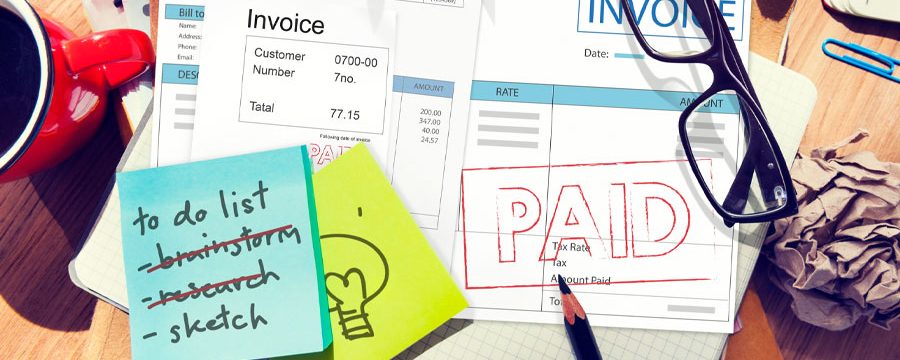For a professional artist, the creation of art is the driving passion. But there’s something else you’ll need to create if you want to run a smooth business and earn a living from your art, and that is your artist invoice.
If you are selling your artwork, providing artistic services, or working on a commission basis, you must be able to provide proper business invoices. Keeping your bookkeeping records in tip-top shape is crucial for any business, and that goes for an art business too. Plus, your customers will expect and request an invoice so they can pay you properly and have an accurate record of their purchase too. Let’s take a deeper dive and see exactly what’s involved in using an invoice for artists:
What to Include in Your Artist Invoice?
In a nutshell, an artist invoice provides documented proof of a customer’s purchase of your artwork or artistic services. This invoice will be used in the customer’s annual accounting reporting, and also yours. In order for an invoice to be valid and effective, it needs to include certain elements and information. Not all are a must, but most are.
For example, the invoice must, of course, include your business name and address, as well as the customer’s name, the date, and other technical information, such as the invoice number, which will be discussed more in-depth below. You must also include the list of items that were purchased and the amount owed by the customer. The invoice can even include notes and comments containing information that is important for the customer to know.
Now, let’s go a step further and drill down to the most important elements of an artist invoice example.
Artwork Invoice
Here are the key elements of an artwork invoice. Make sure you include these in every invoice for purchases of your art:
Artist’s business name and address
The invoice must display your business name and address. This should match your registered business details. If you have a business ID number, this should be included too. You can also include a telephone number, email address, and website address if you have one. This is not a must, but it gives a more professional business-like appearance to the invoice.
Logo
A logo is not a legal requirement of an invoice, however, it is a great way to communicate the brand identity of your business and make your invoice professional and aesthetically pleasing. As an artist, the visual impression of your invoice design is even more important, as it is a reflection of your style and skills.
Invoice number
Every invoice must have its own unique number. This is crucial to maintaining an organized record of all your invoicing activity. If using online invoicing software, the system will generate the number automatically in chronological order.
Customer details
The customer’s name and address must appear on the invoice. This may not be their personal name – it could be a business name, for example, or someone else’s name. This is important to get right, as it will affect the customer’s accounting records and may have implications for their tax preparations. Make sure to contact the customer and verify what name they want on the invoice.
Item specifications
The invoice must include a list of all the art pieces the customer is being billed for. Each item should have a short description detailing the specifications of the piece, so it is clear to the customer exactly which artworks they are being billed for.
Item cost
Each artwork has the cost displayed in a corresponding column.
Taxes & discounts
Any applicable taxes or discounts are included at the bottom of the item list, and they are calculated into the total amount.
Total amount due
This is the final amount owed by the customer. It is the sum of all items on the invoice, minus any discounts (ie. advance payments), plus any applicable taxes. The figure should be displayed boldly and clearly so it is obvious to the customer.
Special message
You can also include a note for the customer on the invoice. This could be a business-oriented message, like terms and conditions, late fee penalties, or which payment methods you accept. You can also personalize it with a more friendly note, such as a thank you message. This is not a must but can add a nice touch to the invoice experience for your customers.
Invoice for Artistic Service
An invoice for artistic services is slightly different, as the nature of billing for artistic services is more complex than simply buying an artwork. Here are the essential items for an invoice for the artist’s services:
Your business details and logo
Just as with the artwork invoice, the artistic services invoice must include your business name and address, and you can include other information, such as an email address and an attractive business logo.
Address of project
If your artistic services are being provided at a location other than the customer’s address, you should include it on the invoice.
Customer details
The customer’s name and address must appear on the invoice. Make sure to use the correct name for their accounting purposes.
Description of art service provided
The item list on the invoice will include the details of the art service, such as an advance payment for commissioned art, hourly service for an ongoing project, etc.
Breakdown of costs
Here you must specify all the different art services and items you are billing the customer for. For example, if you are charging for the materials used in the artistic service, you should detail them in the item list. If you are charging by the hour for the artistic service, you should include the hourly rate in the “Cost per item” column, and the number of hours worked in the “Quantity” column. Then the cost per item and quantity are multiplied to arrive at the total cost for the hourly service provided.
Payment terms and conditions
It is advisable to include a detailed explanation for the terms and conditions of the art service so that the customer knows exactly what to expect. For example, if a commissioned work requires advance payment or upfront purchase of materials or if there is a specific payment schedule for a long term project, all this should be outlined. You can also include information about your late fee policy and which payment methods you accept.
Amounts due
Artistic services typically include more complex charges than a simple artwork purchase. The different amounts will need to be displayed clearly and logically. For example, the amounts owed for the purchase of the materials, the amount owed for hourly services, discounts that need to be applied when an advance payment has already been paid, any applicable taxes, and so on. The total amount due is the most critical number and it will appear at the bottom of the invoice. However, it is important that the customer be able to see all the different sub-totals for specific items so they can understand how you arrived at the final amount due.
Special message
If you feel comfortable with it, don’t forget to personalize your invoice with a friendly note, such as a thank you message.
Using an Artist Invoice Template
When using online invoicing software, there is a major advantage: the invoice template. Online invoicing software comes built-in with templates for professional-looking invoices, featuring all the necessary elements already designed and configured. All you need to do is choose a template design, insert your logo and click “Create”. Then you can generate invoices for your art business quickly and easily, every time. Here are some of the key benefits of online invoicing for artistic services:
Saves time and effort (so you can focus on art)
Once you have completed the template setup, you never have to fuss with invoice design again. Simply enter the customer information and details of the purchase, and with a click of the mouse, the system automatically generates the invoice and you can immediately send it via email to the customer. This saves loads of time and effort, and cuts the need for handwriting invoices and mailing them in the post.
Can be adapted to any kind of art commission or service
The beauty of online invoicing is that all the elements are already there: you just need to enter the relevant purchase information for each specific invoice. Whether a commissioned piece, ongoing artist project, or any other kind of artistic service that needs to be billed for, the invoice template is versatile enough to contain it all.
Invoice Software for Artwork
If it seems like a printed invoice pad isn’t quite doing the job, here are some of the main advantages of moving over to online invoicing software for artwork and artistic services:
Automated and computerized
With online invoicing software, all customer and invoicing data is computerized in a central place, accessible by login in from anywhere. The automated system does all the work of calculating invoicing for you, reducing errors, and keeping perfect accuracy.
All kinds of handy features
With online invoicing, you can benefit from various advanced features that make invoicing even more organized and effective, such as automated recurring billing for ongoing art projects, reminder invoices for late payments, and accounting reports at a click of the mouse so you can see an up-to-date picture of your earnings and outstanding payments.
Simple to use
Best of all, you can create professional invoices and manage all your invoicing processes properly and accurately, with no need for special computer skills and without needing to outlay a lot of money on fancy software, which is great for working artists on a budget.
Turn your passion into a real business
While invoicing is not the central focus of a professional art business, it is a critical one. With the help of online invoicing software, artists can take the hard work out of invoicing, and devote more time to their true passion. Whether selling art pieces or billing for artistic services, efficient invoicing is one of the keys to turning your passion into a streamlined business.



